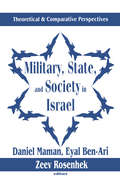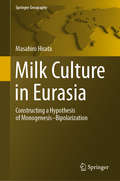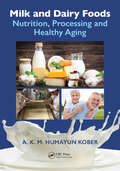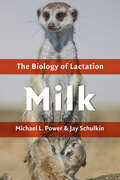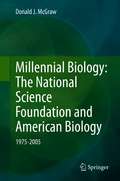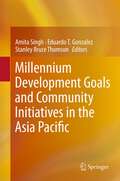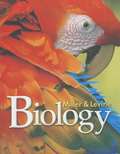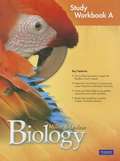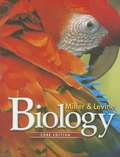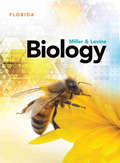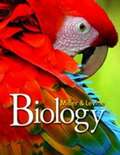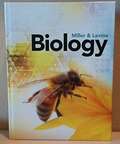- Table View
- List View
Military, State, and Society in Israel: Theoretical and Comparative Perspectives
by Daniel MamanThere have been many books on the place of war, security, or military service in Israeli society. The Military, State, and Society in Israel makes contributions to the debate-theoretical, empirical, and polemical-that are related to the Israeli case and to wider debates about the place of war and the military in contemporary industrialized societies. The Israeli case is important in the development of more macro approaches to the study of "things military" as war has played a central role in Israel's history and continues to do so. The book encapsulates in a very explicit manner tensions in the relationships between the military, state, and society and stands at the core of contemporary debates between two fundamental approaches to the study of the relations between the military society and the state: the "armed forces and society" school and the "state-making and war" perspective.Contemporary Israel is the site of debates about many of the fundamental assumptions that have undergirded the Jewish nation-state: the ethnic character of nationhood and statehood; the role of the Jewish diaspora vis-Ó-vis Israel; the legitimacy of Jewish "ethnic pluralism"; the meaning of the Holocaust; privatization of social life and the spread of consumerism; and weakening of the centralized state as the agent of social transformation affecting housing, language, health, technology, production, dress, and child-rearing. One important consequence of these internal conflicts and struggles has been a significant erosion in the almost sacred status once enjoyed by state institutions, and especially the military, among the majority of Jewish population."Theoretical and Comparative Perspectives," situates Israel in its wider theoretical and comparative context and shows how the study of Israel contributes to the theoretical understanding of contemporary changes in civil-military relations. "The Politics of Civil-Military Relations," concentrates on current changes in Israeli politics, the character of the conflict with the Palestinians, and the place of military in society. "The State and War-Making-Creating Citizens, Soldiers, and Men and Women," indicates how war and the military are not only instruments for state-making, but are also important factors in the formation of individual identities. "The Notion of 'National Security'-Institutions and Concepts," raises the basic question of whether the institutional mechanisms and the strategic conceptions crystallized during the first 50 years of Israel's existence are still relevant in a changing post-cold war world. "The Armed Forces as Organization, Continuity and Change," focuses on the lines of continuity and trends of change in several aspects of the Israeli Defense Forces' internal organizational structure.Studies based on Israeli cases, data, and scholarship have been central to the development of expertise in such fields as applied psychology and psychotherapy. This volume contributes to these areas of study, and will be of central importance to professionals interested in civil-military.
Milk Culture in Eurasia: Constructing a Hypothesis of Monogenesis–Bipolarization (Springer Geography)
by Masahiro HirataThe invention of milking and milk use created a new mode of subsistence called pastoralism. On rangelands across Eurasia, pastoralists subsist by extensive animal husbandry and by processing their animals’ milk. Based on the author’s fieldwork over more than two decades, this book details the processing systems and uses of milk observed in pastoralist and farm households in West Asia, South Asia, North Asia, Central Asia, the Tibetan Plateau, and Europe and the Caucasus. Milk culture in each region is characterized by its processing technology and use of milk, and characteristics common to wider geographical spheres are identified. Inclusion of case studies from the literature expands the continent-wide perspective and provides further indications of how milk culture developed and diffused historically. The inferences drawn are expressed in the author’s monogenesis–bipolarization hypothesis of Eurasian milk culture, that milking and milk processing had a single center of origin in West Asia, and that the technology involved the spread from there across the continent, developing distinct characteristics in northern and southern spheres. Finally, because milk culture underpins pastoralism as a mode of subsistence, the typology and theory of pastoralism are re-examined from the standpoint of milk culture.
Milk Production Management
by Prafullakumar V. Patil Matsyagandha K. PatilMilk Production Management, as the name implies, provides the information on different aspects related to Milk Production Management. The information in this book will be of practical utility for actual feeding of animals e.g. chapters on various rations, nutrient requirement tables, feeding of pregnant/lactating animals, feeding of calves, silage making, hydroponics technique, azolla production different feeds and fodders, fodder cultivation, computation of rations for dairy animals, feeding during scarcity periods etc. In this book different topics like common disease problems of dairy animals and their prevention and control, methods of selection, different breeding systems, semen collection and artificial insemination, different biotechniques used in animal husbandry, milking methods, embryo transfer technique, judging of cows and buffaloes, milk synthesis and milk secretion, record keeping at dairy farms, reproductive aspects of dairy animals etc. are also covered.The book also covers different terms related to animal husbandry. This book is written in simple understandable language with description of those concepts which are useful for actual management of animals. Note: T&F does not sell or distribute the Hardback in India, Pakistan, Nepal, Bhutan, Bangladesh and Sri Lanka.
Milk and Dairy Foods: Nutrition, Processing and Healthy Aging
by A. K. KoberMilk and Dairy Foods: Nutirtion, Processing and Healthy Aging focuses on updated knowledge about the effect of milk and dairy foods on healthy aging. It outlines the nutritional and health benefits of milk and major dairy foods. This book also covers the milk processing and manufacturing process of value-added dairy foods such as yogurt, cheese, cream, butter, ghee, powdered milk, condensed milk, ice cream, and traditional dairy foods.The text discusses the global milk and dairy-food production trends, opportunities, and challenges along with the chemistry and microbiology of milk. The book also includes in-depth discussions of the immunomodulation potential of dairy foods particularly probiotics fermented dairy foods.Key Features Emphasizes that eating whole and low-fat dairy products is not linked to an increased risk of cardiovascular diseases Focuses the processing techniques of high-quality value-added products Covers various kinds of dairy foods, their production, nutritive values, and health attributes Includes quality control and the chemotherapeutic value of different dairy foods including South Asian traditional dairy foods Reviews a range of dairy foods such as yogurt, cheese, cream, butter, ghee, powdered milk, condensed milk, ice cream, and traditional dairy foods Discusses dairy food innovations from production to nutritional and health attributes Illustrates more than 200 key concepts Highlights the role of the dairying in supporting the achievement of the UN sustainable development goals Each chapter includes learning objectives as well as a bubble box for the convenience of readers Each chapter contains value-added dairy items/issues with the latest information that is crucial for students, professionals, and readers This book is meant for undergraduate and postgraduate students in food science, dairy science, nutrition, microbiology, medical, veterinary, biotechnology & allied disciplines, and those involved in formulating and producing dairy foods.
Milk and Honey: Technologies of Plenty in the Making of a Holy Land
by Tamar NovickAn innovative historical analysis of the intersection of religion and technology in making the modern state, focusing on bodily production and reproduction across the human-animal divide.In Milk and Honey, Tamar Novick writes a revolutionary environmental history of the state that centers on the intersection of technology and religion in modern Israel/Palestine. Focusing on animals and the management of their production and reproduction across three political regimes—the late-Ottoman rule, British rule, and the early Israeli state—Novick draws attention to the ways in which settlers and state experts used agricultural technology to recreate a biblical idea of past plenitude, literally a &“land flowing with milk and honey,&” through the bodies of animals and people. Novick presents a series of case studies involving the management of water buffalo, bees, goats, sheep, cows, and peoplein Palestine/Israel. She traces the intimate forms of knowledge and bodily labor—production and reproduction—in which this process took place, and the intertwining of bodily, political, and environmental realms in the transformation of Palestine/Israel. Her wide-ranging approach shows technology never replaced religion as a colonial device. Rather, it merged with settler-colonial aspirations to salvage the land, bolstering the effort to seize control over territory and people.Fusing technology, religious fervor, bodily labor, and political ecology, Milk and Honey provides a novel account of the practices that defined and continue to shape settler-colonialism in the Palestine/Israel, revealing the ongoing entanglement of technoscience and religion in our time.
Milk: The Biology of Lactation
by Jay Schulkin Michael L. PowerEverything you ever wanted to know about the substance that binds all mammals together.After drawing its first breath, every newborn mammal turns his or her complete attention to obtaining milk. This primal act was once thought to stem from a basic fact: milk provides the initial source of calories and nutrients for all mammalian young. But it turns out that milk is a much more complicated biochemical cocktail and provides benefits beyond nutrition. In this fascinating book, biologists Michael L. Power and Jay Schulkin reveal this liquid’s evolutionary history and show how its ingredients have changed over many millions of years to become a potent elixir. Power and Schulkin walk readers through the early origins of the mammary gland and describe the incredible diversification of milk among the various mammalian lineages. After revealing the roots of lactation, the authors describe the substances that naturally occur in milk and discuss their biological functions. They reveal that mothers pass along numerous biochemical signals to their babies through milk. The authors explain how milk boosts an infant’s immune system, affects an infant’s metabolism and physiology, and helps inoculate and feed the baby’s gut microbiome. Throughout the book, the authors weave in stories from studies of other species, explaining how comparative research sheds light on human lactation. The authors then turn their attention to the fascinating topic of cross-species milk consumption—something only practiced by certain humans who evolved an ability to retain lactase synthesis into adulthood. The first book to discuss milk from a comparative and evolutionary perspective, Power and Schulkin’s masterpiece reveals the rich biological story of the common thread that connects all mammals.
Millennial Biology: The National Science Foundation and American Biology, 1975-2005
by Donald J. McGrawNational Science Foundation (NSF) is a unique federal agency because it supports scientific research financially, but does not engage in scientific work itself. Its history is known only in part because the NSF is a vibrant, expanding, and living entity that makes the final telling of its story impossible. Much can be learned from its beginning as well as its component parts. If the founding of the NSF in 1950 was couched in an era of physics, especially atomic physics, certainly by the end of the 20th century and the beginning of the 21st, biology was, and remains, the queen of sciences for the predictable future. This book highlights the elite status of America’s biological sciences as they were funded, affected, and, to a very real degree, interactively guided by the NSF. It examines important events in the earlier history of the Foundation because they play strongly upon the development of the various biology directorates. Issues such as education, applied research, medical science, the National Institutes of Health, the beginnings of biotechnology, and other matters are also discussed.
Millennium Development Goals and Community Initiatives in the Asia Pacific
by Amita Singh Eduardo T. Gonzalez Stanley Bruce ThomsonThe book brings together implementation studies from the Asia Pacific countries in the context of the deadline of 2015 for achieving the Millennium Development Goals. The contributors to this volume are scholars belonging to the Network of Asia Pacific Schools and Institutes of Public Administration and Governance (NAPSIPAG). NAPSIPAG is the only non-West governance research network presently located at Jawaharlal Nehru University, New Delhi after having shifted from its original location at INTAN (Government of Malaysia) at Kuala Lumpur in 2009. 'Implementation' is a less understood but a much debated area of governance research. It requires micro-level analysis of government agencies, service delivery departments and stakeholders on one hand and its national and global policy level connections on the other. Implementation studies are above disciplinary divides and subsequent disjunctions which inhibit explorations on policy downslides or failures. The studies relate to the new initiatives which governments across the region have undertaken to reach out to the MDG targets agreed upon in 2000. The focus of analysis is the policy framework, local capacities of both the government agencies and people in drawing partnerships with relevant expert groups, ability to bring transparency and accountability measures in transactions for cost-effective results, leadership and sustainability dimensions which influence the functioning of local agencies. The book is especially important in the background of 15 voluminous Administrative Reforms Commission Reports accumulating dust in India and similar efforts lying unattended in many other countries of this region as well. Countries like Malaysia, which has focused upon 'implementation strategies' combined with timely evaluation and supervision of administrative agencies has almost achieved most of their committed MDGs. A special report of Malaysian efforts, initiates the debate of moving beyond the 'best practice research' in implementation arena. The central idea of this book is to demonstrate the role of communities in making governance effective and government responsive to the needs of people.
Miller & Levine Biology
by Kenneth R. Miller Joseph LevineA great option for low-level and inclusion classrooms, with digital support on Biology. com. Authors Ken Miller and Joe Levine deliver the same trusted, relevant content in more accessible ways! Written at a lower grade level with a reduced page count, the text offers additional embedded reading support to make biology come alive for struggling learners. Foundations for Learning reading strategies provide the tools to make content accessible for all your students.
Miller & Levine Biology
by Kenneth R. Miller Joseph S. LevineAuthors Ken Miller and Joe Levine deliver the same trusted, relevant content in more accessible ways! Written at a lower grade level with a reduced page count, the text offers additional embedded reading support to make biology come alive for struggling learners. Foundations for Learning reading strategies provide the tools to make content accessible for all your students.
Miller & Levine Biology (Alabama Edition)
by Kenneth R. Miller Joseph Levine"The respected author team of Ken Miller and Joe Levine are back with a new edition of biology books to inspire students to interact with trusted and up-to-date biology content. The authors' unique storytelling style engages students in biology, with a greater focus on written and visual analogies.
Miller & Levine Biology (Oregon Edition)
by Kenneth R. Miller Joseph S. LevineMiller & Levine Biology offers educators an unprecedented opportunity to address the needs of today's classroom in a fresh new way with: - Integrated inquiry throughout each lesson - Engaging visuals that enhance instruction - The next-generation of digital instruction built for 21st Century learners - Differentiated instruction and accessible content that helps to address all types and levels of learners. The text encourages inquiry-based discovery by asking students to think like scientists through a variety of organizing principles and features.
Miller & Levine Biology 2010 Study Workbook A
by PearsonStudy Workbook A for Miller & Levine Biology is designed to help you acquire skills that will allow you to study biology more effectively. Your active participation in class and use of this workbook can go a long way toward helping you achieve success in biology. This study workbook can be used to preview a chapter, learn key vocabulary terms, master difficult concepts, review for chapter and unit tests, practice 21st Century Skills.
Miller & Levine Biology, Core Edition
by Kenneth R. Miller Joseph S. LevineThe Core Edition of Miller & Levine Biology is the perfect option for a classroom looking for a concise textbook that is light on the book bag. Accompanied by robust digital support on Biology.com, the Core Edition covers the following standards-based units: the Nature of Life, Ecology, Cells, Genetics, Evolution
Miller & Levine Biology, Foundation Edition
by Kenneth R. Miller Joseph S. LevineNIMAC-sourced textbook
Miller & Levine Biology, Foundation Edition
by Kenneth R. Miller Joseph S. LevineNIMAC-sourced textbook
Miller & Levine Biology, Foundations, Reading and Study Guide Workbook
by Prentice-Hall StaffNIMAC-sourced textbook
Miller & Levine Experience Biology
by Kenneth R. Miller Joseph S. Levine Carol BakerNIMAC-sourced textbook
Miller & Levine Experience Biology: The Living Earth
by Kenneth R. Miller Joseph S. LevineNIMAC-sourced textbook
